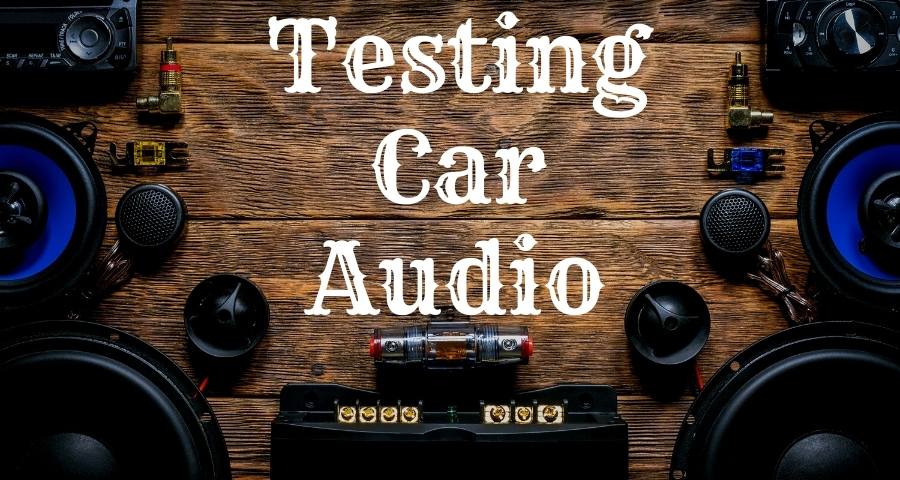
How Do You Test Car Audio Equipment?
It will be challenging to find a true music lover who doesn’t have a good audio system in their car. An audio system usually combines many electronic devices that deliver quality audio output. It allows you to enjoy music without any interference from outside sources. Unfortunately, car audio systems can experience problems sooner or later.

The problem can occur due to old age, mismatched components, or incorrect connections. In such situations, you can fix these problems by diagnosing your car’s audio system. You can diagnose your audio system with different tools available on the market. Through this article, we will let you know some widely used tools that can be used to test your car’s audio system.
Different Tools for Testing Car Audio Systems
Fixing a car’s audio system will be challenging without knowing the problem. In that case, some tools can help you to test your car’s audio system. Below, we have discussed some such tools to diagnose cars’ audio systems.
Oscilloscope
An oscilloscope is a device that diagnoses the signal strength of different audio signals from a car. It has a screen that shows the signal’s amplitude over time. For that, you will see audio waves receiving signals from your car’s stereo system. The tool also displays a graphic representation of the sound waves produced by the stereo. This way, you can easily troubleshoot your car audio system with this tool.
Furthermore, oscilloscopes allow you to monitor audio signals with sine waves and detect issues in your audio system. For that, you can easily detect and fix your car’s audio system fault. However, you will find different types of budget oscilloscope for car audio system checking on the market. With this device, diagnosing your car’s audio system will be easy for you.
Real-Time Analyzer
A real-time analyzer is an audio tool that measures and displays an audio signal’s frequency spectrum. Music consists of different frequencies, and the audible spectrum of a song can be 20–20,000 Hz. An RTA allows you to examine such frequencies coming from your car’s audio equipment. It displays a visual representation of the frequencies that helps to detect the issues with your car.
Typically, a real-time analyzer uses an external microphone as an input to detect sound coming from your speaker. The good thing is that it can detect sounds that can’t be heard by ear. For that, you can easily detect and fix how a given car’s acoustics affect the output through an RTA.
SPL Meter
An SPL meter refers to the sound pressure level that helps measure sound intensity or loudness in decibel terms. It is a mobile and lightweight device that is used to measure noise levels and identify sources quickly. Typically, this device is designed with a microphone that detects the surrounding sound.
After that, the meter analyzes the sound signals, transforming them into electrical data and measurement values. SPL meters measure sound pressure levels in the range of 20 to 140 decibels. If this sound pressure is present in your car, it will detect it automatically and display the reports to identify the appropriate source.
What Do You Do With A Car Oscilloscope?
You can measure and detect different audio signals, including a car audio system with a car oscilloscope. Below, we have discussed some common uses of an oscilloscope.
Measure Voltage and Signals
Voltage and signals can be measured with an oscilloscope, which is very helpful for audio engineers, musicians, and sound system technicians. You can also determine whether a speaker is working properly by measuring voltage and signals. Besides, this tool is very helpful for checking the audio system’s health.
Clipping and Distortion
Identifying clipping can be difficult by ear alone if it is not excessive. In that case, an oscilloscope will be a good choice to detect the clipping problem. As oscilloscopes can display audio waves, you can use them to detect clipping. This way, it will be easy for you to detect and fix if your stereo is clipping and distorted.
Graphical Display
An oscilloscope displays the flow of signals around your audio system. Fixing or troubleshooting any audio issue will be easy by seeing the flow of signals. This is very helpful when looking for any malfunction in your audio system.
Controlling Output Quality
No one may want to hear noise or distortion in audio because it will ruin the quality. Using an oscilloscope, you can easily control the quality of your audio system’s output. This tool lets you adjust the sound you like to hear.
To Set Gains
An oscilloscope can be used to set your car’s amp gains. It allows you to adjust the amp gain according to your preference. However, you shouldn’t set gains with too much precision, as music is recorded at different levels.
How To Use An Oscilloscope For A Car Audio System?
Through an oscilloscope, you can easily troubleshoot your car’s audio system. Below we have discussed a complete guideline using an oscilloscope for car audio.
- To set the amplifier, locate the head unit’s clipping point first. Turn off the time alignment setting to disconnect the input from the head unit.
- Once you disconnect properly, take a testing CD or play a testing tone. Typically, the measurement of standard tone is 50Hz for Sub-Woofers-3db, 1000Hz-3db for Mids, and 3500Hz-3db for Tweeters.
- Now, adjust the oscilloscope to an accurate volume. After that, measure the frequency of each channel from the output signal of the source unit.
- You will notice that the sine waves start to equalize as soon as the volume increases. You should remove the flat spots so that the car’s audio system is not damaged.
- Your recorded volume level will be your individual volume level; you cannot make the sound louder than that. Reinstall the amplifier in the source unit and set the volume to its highest setting.
- Now connect the oscilloscope to your car audio and re-connect the speakers into the amplifier.
Which Brand of Car Subwoofers Should I Use to Test Car Audio Systems?
When it comes to testing car audio systems, the choice of subwoofers plays a crucial role. To ensure an accurate assessment, the best car subwoofers brand showdown is essential. This competition allows for a fair comparison of different brands’ performance and quality. By using the best car subwoofers, you can accurately evaluate the capabilities and potentials of various car audio systems.
Conclusion
Driving a car without music is unimaginable, especially for music lovers. Unfortunately, it is common to have some problems with the vehicle’s audio system. If you don’t find the actual reason for the car’s sound issue, repairing it will be challenging. In that case, testing your car audio system with diagnostic tools will be the easiest way to find the problem.
However, there are different tools you will find, but we have picked the most widely used ones that you can use to test your car’s audio. Among those three tools, an oscilloscope is the most popular one, which is easy to use and diagnose any car’s audio system. You can easily troubleshoot your audio system with an oscilloscope following the steps described above.



